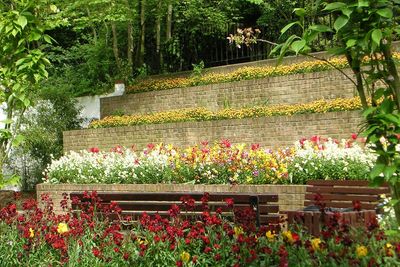What is a Tiered Garden?
A tiered garden consists of one or more retaining walls which form two or more level areas. For homes that are built on hills, creating a tiered garden design will not only make the yard more usable, but it can also increase the value of the property by adding outdoor living space. What should homeowners consider when building a tiered garden? Safety is a major concern. The retaining walls require the proper footing, anchoring, and drainage to withstand the wrath mother nature hurls at them. To maximize safety, the tiered garden design might also include steps to access the various levels, lighting, and, in some cases, a handrail or railing.
Building a Tiered Garden
Building a tiered garden can be a more advanced DIY project. It may require the use of heavy equipment, such as a backhoe or skid steer, and an in-depth understanding of outdoor construction techniques. For larger tiered garden projects, hiring a retaining wall specialist or landscape designer can save homeowners money in the long run by avoiding costly mistakes. Not all tiered projects need to be that big or expensive. Adding a tiered garden bed around a tree in the front yard or creating multi-level landscaping around the house can improve curb appeal. Man-made retaining wall blocks have become a popular choice for gardening in tiers. These products are affordable, readily available, and manufacturers offer easy-to-follow installation instructions.
Tiered Garden Planting Ideas
During the planning stages for a tiered garden bed, also consider plant selection. Keep in mind different levels of a tiered garden can create various growing conditions. Higher levels will dry quicker than lower ones. Consider reserving those top tiers for succulents like portulaca, or drought-loving flowers such as gaillardia, verbena, or lantana. Moisture retention will be better at lower levels, especially if there’s a water feature in the tiered garden. Planting ideas for these lower levels can include moisture-loving plants such as irises, elephant ears, and ferns. Upper levels and taller plants can also cast shadows on shorter, lower plants. Try hosta, bleeding heart, or astilbe for those less sunny spots. These perennials don’t have long bloom times, but their attractive foliage keeps the garden interesting throughout the growing season. Finally, keep plant height in mind when making your selections. One option is to plant taller perennials near the back of each level while reserving the front of the tiered garden bed for shorter, long-blooming annuals. Choose phlox, poppies, or lilies to add a splash of color in spring and early summer while the annuals are getting established. Then augment the garden with marigold, ageratum, or petunias for waves of color that can be enjoyed all summer long!
